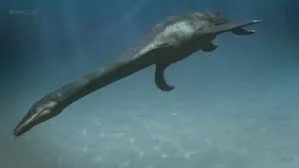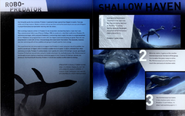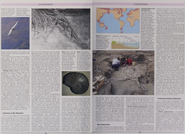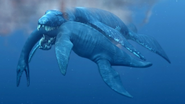Kimmerosaurus is a plesiosaur which lived in the Middle Jurassic period (165-155 MYA). It was about 6,5 metres (19.5 ft) long and weighed about 1 ton. Its neck was about 2 metres (6 ft) long.
Description[]
Plesiosauroids in which tooth oranment is absent: the teeth are greatly recurved, sharply pointed and buccolingually compressed; the premaxilla bears at least 8 teeth; the dentary bears 36 teeth on each ramus; the parietals do not form a sagital crest; the quadrate overlaps the quadrate ramus of the pteryogoid anterolaterally; the paraoccipital process of the exoccipital-opisthotic is realtively short and massive; the occiptal condyle is not ringed by a groove, and extends onto the pedicles of the exocciptal. The postcranial skeleton is not known. There are Two Species Recorded; Kimmerosaurus langhami
Kimmerosaurus sp
Discovery[]
There are very few fossil remains of Kimmerosaurus known. In fact, nothing has been found to show what Kimmerosaurus may have looked like below the neck, although the atlas and the axis are similar to those of the plesiosaur Colymbosaurus. It is this lack of any post-cranial fossils, and the bone similarities that has led to the belief that Kimmerosaurus fossils could be the missing head of Colymbosaurus, a similar plesiosaur with no known skull fossils. The first part of the genus name of Kimmerosaurus comes from the location of the first Kimmerosaurus fossils, Kimmeridge Clay deposits of Dorset, England (these deposits are also the root word for the Kimmeridgian stage of the Jurassic period). The second part comes from the Greek word σαυρος (sauros), "lizard".
Paleoecology[]
Kimmerosaurus fossils are found in the Kimmeridge Clay Formation near the town of Kimmeridge, in Dorset, England. This animal may have ranged through much of what is now the Jurassic Coast, a world heritage site in the southern United Kingdom.
Etymology[]
In reference to the stratigraphical horizon of the type specimen in the Kimmeridgian stage, Kimmeridge Clay, Greek, sauros, 'lizard': Kimmeridge lizard.
Species[]
Kimmerosaurus langhami[]
Etymology[]
It is named after the founder of it Mr. Robert Langham
Diagnosis[]
As for genus (monospecific genus)
Note[]
Kimmerosaurus is known only from the skull and first few (rather crushed) cervical vertebrae. Colymbosaurus, which occurs in the same formations, is known only from post-cranial elements. Both have been identified as Crytoclidids, and there is a possiblity that they are the same taxon














